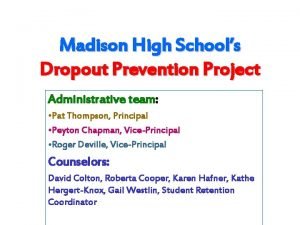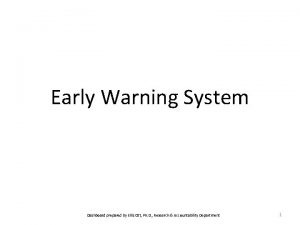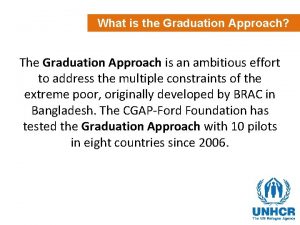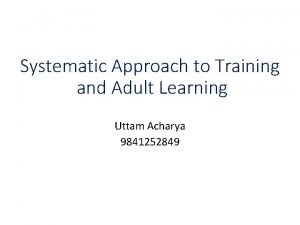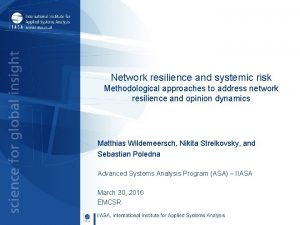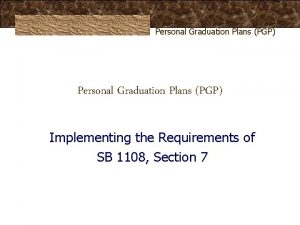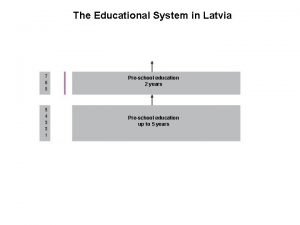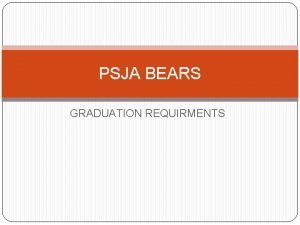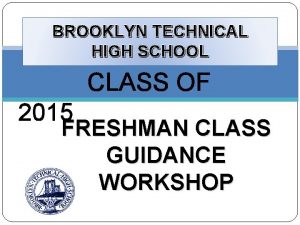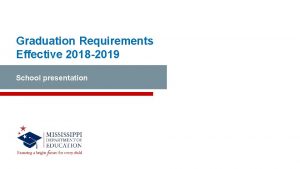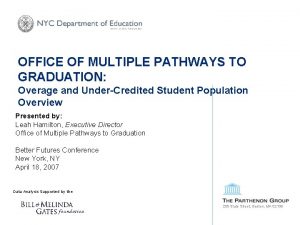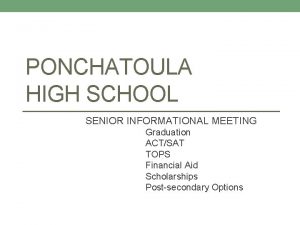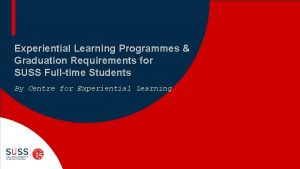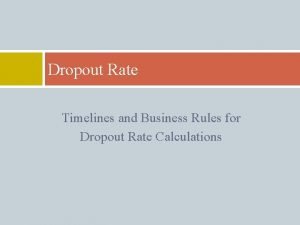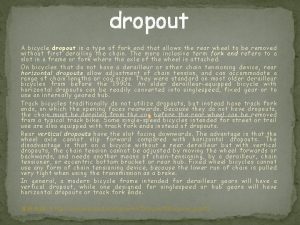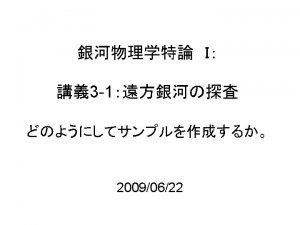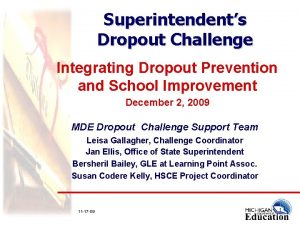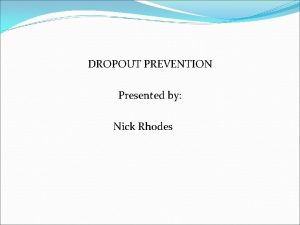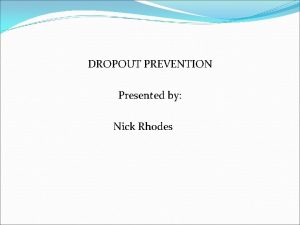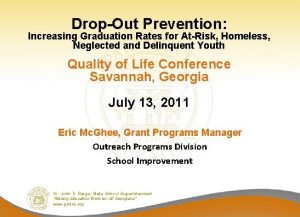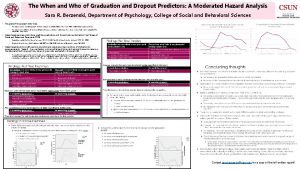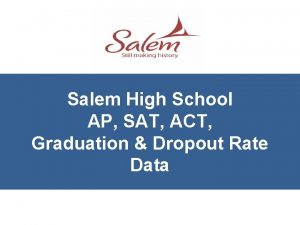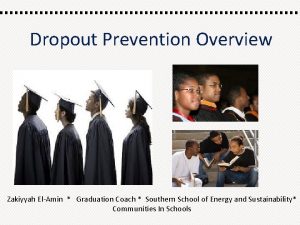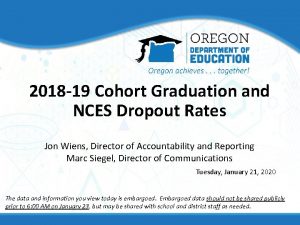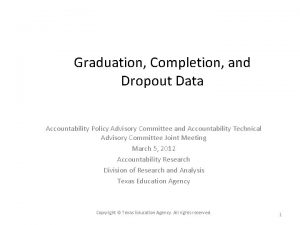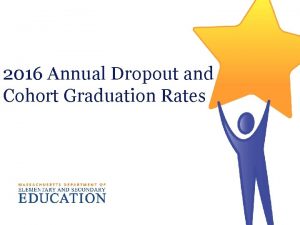Systematic Approach to Dropout AASystematic Approach to Graduation






















![LEAST RESTRICTIVE ENVIRONMENTS WEST VIRGINIA DECEMBER 1, 2014 [CATEGORY NAME] 64% Parentally Placed in LEAST RESTRICTIVE ENVIRONMENTS WEST VIRGINIA DECEMBER 1, 2014 [CATEGORY NAME] 64% Parentally Placed in](https://slidetodoc.com/presentation_image_h2/5e08da517ff956af708b20907b5c50ad/image-23.jpg)



























































- Slides: 82


Systematic Approach to Dropout AASystematic Approach to & Graduation Dropout & Graduation Gearing Up for Action

3 Choices are NEVER this Obvious Drop Out of School Stay In School

A Look At The Nation What We know

Good News- Grad Nation Report § While no state has yet achieved an on-time 4 year cohort rate of 90%, five states are within two points at 88% - IA, VT, WI, NE, TX § There is a decline by 1/3 over the past decade (2, 007 in 2002 to 1, 359 in 2012) in the number and % of students attending high schools in which the graduation rate is less than 60%. § The first ever adjusted cohort graduation rate shows the nation crossed the 80% threshold in 47 states for the first time in history.

More Good News- Grad Nation Report § Since 2006, gains have been driven by a 15% point gains for Hispanic students and 9% gains for African American students § If this average of 1. 3% points per year is maintained during the next 8 years, the nation will reach its 90% graduation goal by 2020 § We have evidence-based and promising practices that can –when implemented over time with fidelity – enable schools to make significant progress in helping youth with disabilities stay in school, progress in school, and graduate

Not So Good News § Students with disabilities: The national average graduation rate for students with disabilities is 20 percentage points lower than the overall national average. • The 90 percent goal will not be reached if students with disabilities, who represent 13 percent of all students nationally, continue to have low graduation rates. • Graduation rates for students with disabilities also vary dramatically by state, with a 24 percent graduation rate in Nevada and an 81 percent graduation rate in Montana.

Not So Good News § Young men of color: In spite of gains made by all students of color over the past six years, young men of color continue to lag behind other subgroups of students. § Most big cities with high concentrations of lowincome students, however, still have graduation rates in the 60 s and a few in the 50 s.

Challenges We Face • Building early warning systems that move beyond identifying youth who are at the threshold of dropping out, but rather creating those systems that contain critical benchmarks and evidence-based interventions that can be used easily by LEAS • Turning the tide of off-track indicators: middle grades are pivotal years, setting a student on a path to high school, college and career, or a path to disengagement and low achievement in key subjects

Challenges We Face § Chronic absenteeism, missing more than 10 percent of the school year, for any reason, is an early indicator of potential dropout and should be addressed. § Turning the tide of off-track indicators: middle grades are pivotal years, setting a student on a path to high school, college and career, or a path to disengagement and low achievement in key subjects.

Challenges We Face • Success in life cannot just come from a classroom education. Students need to develop additional skills, such as self-awareness and self-control, and collaboration and conflict resolution to stay in school, graduate, and become productive members of society. • The realization that academics alone may not be enough. Students have to want to come to school, work hard, and graduate on time. And they have to feel capable of achieving their academic goals. The challenge for educators and parents is to figure out how to make that happen.

What Can Be Done • Awareness • Accountability • Action – Targeted reform in secondary schools – Targeted interventions – Closing the opportunity gap – Building sustainable systems

This framework helps conceptualize and structure the work in a systematic and comprehensive manner that helps a team implement and sustain their local school-completion initiative © 2007 National Dropout Prevention Center for Students with Disabilities at Clemson University – All rights reserved

14 Ten Things You Can Do to Improve Graduation Rates • Utilize data systems to identify, inform, monitor and track increased graduation rates for students with disabilities • Implement increasingly intensive evidence based methodologies toward improved academic outcomes in core academic areas • Implement increasingly intensive evidencebased methodologies to improve social, emotional, and behavioral outcomes DC

15 Ten Things you can do to Improve Graduation Rates • Promote the implementation of attendance strategies and alternative programs to increase the likelihood that students will attend school regularly • Promote and ensure culturally responsive learning environments and instructional practices • Provide rigorous and relevant instruction to better engage students in learning both academic and career skills DC

16 Ten Things you can do to Improve Graduation Rates • Provide options for students with disabilities to be engaged in increasing intensive opportunities to participate in career related, work based, and supported employment • Embrace a philosophy of partnerships that empowers families, communities, and other stakeholders to become meaningfully involved in the improvement of outcomes for all students DC

17 Ten Things you can do to Improve Graduation Rates • Promote the development of personalized learning environments that creates a sense of belonging and fosters a school climate where students and teachers get to know one another and can provide academic, social, and behavioral encouragement • Provide educators with ongoing professional development and technical assistance to expand their knowledge and improve their skills in implementing increasing intensive EBPP’s related to 1 -9 DC


West Virginia’s Landscape Demographic Data

West Virginia’s Landscape • The State identified analyzed key data, including data from SPP/APR indicators, 618 data collections, and other available data (including stakeholder input) to select the draft SIMR and start to identify root causes contributing to low performance.


![LEAST RESTRICTIVE ENVIRONMENTS WEST VIRGINIA DECEMBER 1 2014 CATEGORY NAME 64 Parentally Placed in LEAST RESTRICTIVE ENVIRONMENTS WEST VIRGINIA DECEMBER 1, 2014 [CATEGORY NAME] 64% Parentally Placed in](https://slidetodoc.com/presentation_image_h2/5e08da517ff956af708b20907b5c50ad/image-23.jpg)
LEAST RESTRICTIVE ENVIRONMENTS WEST VIRGINIA DECEMBER 1, 2014 [CATEGORY NAME] 64% Parentally Placed in Privace School (LRE=8) 1% OSE (LRE=5) 1% [CATEGO RY NAME] 8% [CATEGORY NAME] 25%

Student demographics, SY 2013 -2014 All students Grades: PK - 12 Of all students, 48% qualify as Low-SES Of all students, 15% qualify as SWD 62% of SWD qualify as Low-SES Data source: End of Year Certified Enrollment file, 2013 – 2014 Notes: Results incorporate all school districts (including WVSDB & Institutional Programs), Grades Pre-K – 12, analysis excludes exceptionally gifted (EG) and gifted (GF) from SWD classification

APTA Participation: Mathematics (2013 – 2014) Hancock Brooke Ohio WV APTA % = 1. 43 (Target APTA % = 1. 0) Marshall Monongalia Wetzel Pleasants Wood Jackson Mason Tyler Ritchie Wirt Putnam Dodd- Harrison ridge Upshur Nicholas Mc. Dowell Tucker Jefferson Grant Hardy Pendleton Pocahontas Fayette Above WV % (> 1. 43) Below WV% (<1. 43) but above 1% Greenbrier At or below 1% target Raleigh Wyoming Hampshire Webster Kanawha Logan Mineral Randolph Braxton Wayne Lincoln Mingo Taylor Morgan Berkeley Lewis Clay Boone Preston Barbour Cal- Gilmer houn Roane Cabell Marion Summers Mercer Monroe APTA % calculated using Grades 3 -8, and 11 WV APTA % excludes the West Virginia School for the Deaf and Blind (WVSDB) and Institutional Programs Data Source: RPTCARD 14_PWVN 307 A

West Virginia’s Landscape Performance Data – Graduation/Drop out

WV Graduation Rate (%) Trends: 2012 - 2014 All students Students with disabilities (SWD) 100 Graduation rate (%) 90 80 81. 4 79. 3 84. 5 Graduation gap = 70 19. 4% 60 59. 9 Graduation gap = 19. 3% 14. 2% 70. 3 62. 1 50 2011 -2012 -2013 Year Graph shows graduation among 4 -year cohort, standard diploma. Data presented are for Cohort Year (actual year of student graduation) which lag 1 year behind Accountability Year. 2013 -2014

WV Graduation Rate (%) Trends: 2012 - 2014 Low-Socioeconomic Status (Low-SES) Students with disabilities (SWD) 100 Graduation rate (%) 90 80. 1 80 72. 2 11. 6% 12. 3% 60 59. 9 gap = 9. 8% Graduation gap = 70 Graduation 73. 7 70. 3 62. 1 50 2011 -2012 -2013 Year 2013 -2014 Graph shows graduation among 4 -year cohort, standard diploma. In 2013 -2014 the definition of low-SES was expanded to include those participating in Community Eligibility Provision (CEP) programs. Subgroups are not mutually exclusive (i. e. , a student qualifying as low-SES may also qualify as SWD). Data presented are for Cohort Year (actual year of student graduation) which lag 1 year behind Accountability Year.

WV Graduation Rate (%) Trends: 2012 - 2014 Male Female 100 Graduation rate (%) 90 83 85 80 70 76 78. 2 87 82. 1 60 50 2011 -2012 -2013 Year Graph shows graduation among 4 -year cohort, standard diploma. Data presented are for Cohort Year (actual year of student graduation) which lag 1 year behind Accountability Year. 2013 -2014

WV Graduation Rate (%) Trends: 2012 - 2014 American Indian/Alaskan 100 93. 6 Graduation rate (%) 90 80 70 60 79. 1 79. 6 73. 8 66. 7 Black White Hispanic 92 Asian 94. 7 88. 6 82. 3 84. 7 81. 9 79. 4 75 69. 6 59. 1 50 2011 -2012 -2013 Year Graph shows graduation among 4 -year cohort, standard diploma. Data presented are for Cohort Year (actual year of student graduation) which lag 1 year behind Accountability Year. 2013 -2014

WV Graduation Rates (%): 2013 - 2014 All students Students with disabilities (SWD) 100 Graduation rate (%) 80 60 81. 3 82. 9 83. 7 82. 8 88. 1 70. 4 69. 3 68. 3 70. 7 RESA 2 RESA 3 RESA 4 RESA 5 60. 3 90. 1 73. 6 85. 6 65. 7 88. 7 73. 3 84. 5 70. 3 40 20 0 RESA 1 RESA 6 RESA 7 Graph shows graduation among 4 -year cohort, standard diploma. Data presented are for Cohort Year (actual year of student graduation) which lag 1 year behind Accountability Year. RESA 8 All WV Counties

Graduation Rates SWD 2013 -2014 - ALL 2013 -2014 - SWD 84. 46% 70. 27% Graduation Gap 14. 19% Highest Performing LEA Lowest Performing LEA Difference Gap 90. 06% 33. 33% 56. 73%

WV Drop Out Rate (%) Trends: 2012 - 2014 All students Students with disabilities (SWD) 3 Drop Out rate (%) 2. 5 2. 2 1. 9 2 1. 5 1. 7 1 1. 5 1. 3 0. 5 0 2011 -2012 -2013 Year The drop out gap between the all students group and SWD group has decreased from 0. 5% in 2011 -2012 to less than 0. 2% in 2013 -2014

WV Drop Out Rate (%) Trends: 2012 - 2014 Low-Socioeconomic Status (Low-SES) Students with disabilities (SWD) 3 2. 5 Drop Out rate (%) 2. 5 2 2. 3 1. 7 2. 2 1. 9 1. 5 1 0. 5 0 2011 -2012 -2013 Year In 2013 -2014 the definition of low-SES was expanded to include those participating in Community Eligibility Provision (CEP) programs. Subgroups are not mutually exclusive (i. e. , a student qualifying as low. SES may also qualify as SWD). 2013 -2014

WV Drop Out Rate (%) Trends: 2012 - 2014 Male Female 3 Drop Out rate (%) 2. 5 2 1. 5 1. 9 1. 7 1. 4 1. 6 1 1. 4 1. 2 0. 5 0 2011 -2012 -2013 Year 2013 -2014

WV Drop Out Rate (%) Trends: 2012 - 2014 American Indian/Alaskan Black White Hispanic Asian 3 Drop Out rate (%) 2. 5 2 1. 5 1 2. 2 2 1. 7 1. 4 1. 2 1. 9 1. 5 1. 3 1 1 0. 7 0. 5 0. 2 0 2011 -2012 -2013 Year The drop out gap between WV’s largest race/ethnicity subgroups, White and Black, has remained near 0. 5% over the past three years. 0. 4 2013 -2014

2013 – 2014 Drop Out Rates (%) Among SWD Grades 7 - 12 HANCOCK BROOKE OHIO MARSHALL MONONGALIA WETZEL PLEASANTS WOOD RITCHIE MASON PUTNAM WAYNE UPSHUR MINGO TUCKER JEFFERSON GRANT RANDOLPH PENDLETON WEBSTER NICHOLAS WV SWD drop out rate = 1. 5% POCAHONTAS LINCOLN BOONE HAMPSHIRE HARDY BRAXTON KANAWHA BERKELEY MINERAL LEWIS CLAY CABELL TAYLOR BARBOUR CAL- GILMER HOUN ROANE PRESTON DODD- HARRISON RIDGE WIRT JACKSON MORGAN MARION TYLER 1. 4 percent or less FAYETTE GREENBRIER LOGAN 1. 5 – 2. 8 percent RALEIGH WYOMING MCDOWELL SUMMERS MERCER 2. 8 percent or greater MONROE County level SWD drop out rates ranged from 0% to 4. 2%

Drop Out Rates SWD 2013 -2014 - ALL 2013 -2014 - SWD Drop Out Gap 1. 5% 1. 3%. 2% Lowest Performing LEA 4. 18% Highest Performing LEA 0. 00% Difference Gap 4. 18%


What Would Participation in GRADUATION 20/20 Mean for My School? August 25, 2015

Develop State, Local and School Leadership Teams – (NDPC-SD) q Establish leadership and design teams q Identify cohort districts / schools q Identify core teams for training q Train teams in framework and modules 1 -8 q Train teams in roll out strategies

In the Beginning q q First Steps West Virginia was chosen to receive technical assistance from the National Dropout Center for Students with Disabilities (NDPC-SD) in 2011 -2014. State Systemic Improvement Plan (SSIP) Stakeholders reviewed graduation and dropout data for students with disabilities and identified it as an area of concern. Pilot schools in RESA 2 trained with the National Dropout Prevention Center for Students with Disabilities (NDPC-SD) in 2014 -2015.

The Process q q q West Virginia chose as the State-identified Measureable Result (Si. MR) for children with disabilities to focus on graduation from high school with a regular diploma in four years. The Superintendent of Schools endorsed this initiative and supported collaboration across offices within the state department. The initiative was endorsed by the Chiefs of the Division of Teaching and Learning & Division of School Effectiveness.

The Process q q Initiative involvement would not be limited only to students with disabilities but all students could get involved. RESA 2 piloted the West Virginia GRADUATION 20/20 initiative to inform coherent improvement strategies and in turn make adjustments to the statewide implementation process.

The Invitation to Participate q q q The State of West Virginia has 117 high schools. Schools were selected for invitation to participate in the project based on a graduation percentage below the state average for students with disabilities (70%). There were approximately 63 schools invited to participate in Cohort 1. Thirty-five counties are included. Cohort 1 and the RESA 2 Pilot represented fifty-four percent of all the high schools in WV.


The Participation Process q q q As a part of the participation process, schools are being asked to complete a memorandum of understanding (MOU). Part of the process involved several district, school and RESA commitments. The idea behind the memorandum of understanding is to increase buy-in by asking for collective commitments from schools, districts and RESAs.

School Commitments q q School system priorities include increasing the percentage of students with disabilities who graduate with a general education diploma and decreasing the dropout rate for students with disabilities. The school will designate a GRADUATION 20/20 School Leadership Team Leader to work directly with WVDE and RESAs to schedule and conduct meetings once a month to facilitate communication and activities and provide time for project activities.

School Commitments q q q The School Leadership Team Leader will attend all Team Leader and team training sessions. The principal and other school administrators are committed to this project and to the school’s participation. One designated administrator from the school will attend all training sessions. The team members will attend all school team trainings and follow-up sessions.

School Commitments q q The principal will ensure that the GRADUATION 20/20 School Leadership Team Leader has regularly scheduled team meetings to complete assignments. These include: data collection, data analysis, action plan development and implementation, and monitoring implementation The Team Leader agrees to collect, analyze and report project evaluation data. The school agrees to serve as a resource for other schools working on similar goals. These goals include: hosting visitors, responding to requests for information, possible conference presentations, etc. The school will make a three-year commitment to the program.

School Requirements for Participation q q …Six days of professional learning with national, state and RESA trainers during year 1 for school teams. …GRADUATION 20/20 team meetings at least once monthly to complete team activities. …Continuation of training and implementation meetings in years 2, 3 and 4. …The School Leadership Team will identify dropout prevention strategies to be implemented utilizing schoolwide data.

School Requirements for Participation q q …Possible changes in schedules, student groupings, policies or instructional strategies if indicated by the School’s Action Plan. …Two-to-three hours of the Team Leader’s time per week for meetings and project-related activities.

The Roll Out q q q Sixty-three schools were selected through the process. Schools will assemble teams and receive their first training individually, through webinars and RESA directed training. This method will allow for the creation of relationships with their RESA contacts.

Analyze Data (NDPC – SD) q District / local school demographics q District and school infrastructure q Current initiatives and partnerships q Student performance (attendance, graduation, dropout, course completion, discipline)

Analyze Data (NDPC – SD) q q q Assessment, curriculum and instructional systems Professional learning (dropout prevention/ intervention, recovery/ re-entry) Relevant policies and procedures (attendance, discipline, promotion/ retention, graduation)

Identify Target Areas for Intervention (NDPC-SC) q School Climate q Attendance and truancy prevention q Behavior (universal, classroom, targeted, intensive management and support)

Identify Target Areas for Intervention (NDPC-SC) q Academic content and instruction (reading, writing, math, science) q Family engagement q Student engagement

Identify Target Areas for Intervention q Schools collect and analyze data q Identify target areas of improvement q q Teams analyze policies and procedures as well as building – and student – level data Schools also look at school climate, discipline referrals, academic rigor, family involvement and student engagement

Develop School Action Plan (NDPC-SD) q q Select evidence-based practices (Check and Connect, Positive Behavioral Interventions and Supports, Cognitive Behavior Interventions, Content Enhancements) Determine level of intensity (universal, targeted, intensive) q Contextualize to setting q Establish timeline q Draft action plan

Evidence-Based Practices q q Provide the option for Positive Behavioral Interventions and Supports (PBIS). West Virginia has a long history of working with PBIS. It is provided free to districts who wish to implement.

Contextual Fit q q Sharing among school will reinforce the concept that each school must do the work around its unique culture and issues. The training does not provide answers for schools; answers would have to come from the group and provide a contextual fit for each building as there in no “one size fits all. ”

School Action Plan Development q q q Once areas of intervention are identified, schools will write a School Action Plan. The School Leadership Team then shares the School Action Plan with building-level staff. Preparation for implementation of interventions begins in schools.

Implement, Monitor and Evaluate (NDPC-SD) q Conduct baseline measures q Train additional staff for rollout q q Implement strategies: on-site coaching, consultation and feedback Progress monitoring, fidelity checks

Implement, Monitor and Evaluate (NDPC-SD) q Measure results q Evaluate outcomes q Celebrate success! q Disseminate

Challenges, Barriers and Solutions q q As leadership changes, sometimes the vision and mission of a school changes as well. The WVDE will continue to offer support to these schools as they request it. Unrealistic ideas of what the training will do for a school. The WVDE will attempt explain the scope of the training prior to school involvement.

Challenges, Barriers and Solutions q q Lack of time and staff for additional supports to provide to schools. The WVDE and RESAs continue to look for ways to provide more time for staff to be in the field offering support to schools. Schools had difficulty accessing data in a format that could be translated into usable information for their purposes. Schools and WVDE examined these systems and were able to find methods for making the data work.

Challenges, Barriers and Solutions q Provide a framework to give more support to schools. The WVDE is committed to listening to the ideas of model schools to provide more scaffolding and support for them as they continue to do this important work.

What Comes Next… q q q In 2016, West Virginia is planning their first GRADUATION 20/20 Capacity Building Forum. The Forum will include model schools and an invited list of attendees based on graduation percentages. It will also serve to recognize and celebrate the successes of committed GRADUATION 20/20 schools.

Memorandum of Understanding Between West Virginia Department of Education And County Boards of Education In response to West Virginia Graduation 20/20 2015 -2017

RESA 1 COUNTY Mercer Monroe Mc. Dowell Raleigh Summers WEST VIRGINIA GRADUATION 20/20 YEAR 1 COHORT RESA ASSIGNMENTS HIGH SCHOOL(S) Bluefield High Montcalm High (7 -12) Pikeview High Princeton Senior High James Monroe High Mount View High River View High Independence High Shady Springs High Woodrow Wilson High Summers County High Priority/Focus Priority Graduation 20/20 Teresa Epperley Teresa Epperley Teresa Epperley RESA 2 Logan Mason RESA 3 RESA 4 RESA 5 Mingo Boone Kanawha Capital High Herbert Hoover High Nitro High Riverside High Saint Albans High Sissonville High South Charleston High Putnam Poca High Winfield High Braxton Fayette Braxton County High Fayetteville High Meadow Bridge High Midland Trail High Oak Hill High Greenbrier East High Pocahontas County High Webster County High Calhoun Middle Ripley High Roane County High Spencer Middle Geary Middle Walton Middle Wirt County High Weir High Greenbrier Pocahonta s Webster Calhoun Jackson Roane RESA 6 Logan Senior High Point Pleasant Jr. /Sr. High Tug Valley High Sherman High Van Junior/Senior High Wirt Hancock Marsha Jarrell Focus – Brenda Parsons Priority – Brian Withrow Priority Focus – Deena Swain Marsha Jarrell Electa Crowder / Dawn Embrey. King Electa Crowder / Dawn Embrey. King Rena Robinson Rena Robinson Jackie Harris Jackie Harris Michelle Hogan

WEST VIRGINIA GRADUATION 20/20 GRANTS TO SUPPORT SCHOOLS YEAR 1 COHORT / PILOT COHORT COUNTY Mercer HIGH SCHOOL(S) Bluefield High Montcalm High (7 -12) Pikeview High Princeton Senior High Monroe Mc. Dowell James Monroe High Mount View High River View High Raleigh Independence High Shady Springs High Woodrow Wilson High Summers Cabell Logan Summers County High Huntington High Logan Senior High Man Senior High Chapmanville Senior High Mason Point Pleasant Jr. /Sr. High Hannon Jr. / Sr. High Mingo Tug Valley High Wayne Boone Wayne High Sherman High Van Junior/Senior High Kanawha Capital High Herbert Hoover High Nitro High Riverside High Saint Albans High Sissonville High South Charleston High Putnam Poca High Winfield High Braxton Fayette Braxton County High Fayetteville High Meadow Bridge High Midland Trail High Oak Hill High AMOUNT YEAR 1 SPECIAL EDUCATION DIRECTOR $10, 000. 00 Todd Browning $2, 500. 00 Brian Baker $5, 000. 00 Aaron Lester $7, 500. 00 Allen Sexton $2, 500. 00 Kim Rodes Karen Veazey $7, 500. 00 Leah Perry $5, 000. 00 John Lehew $2, 500. 00 Janet Varney $2, 500. 00 Kim Adkins $5, 000. 00 Mary Knapp $17, 500. 00 Kate Porter $5, 000. 00 Annette Pratt $2, 500. 00 Judy Shaffer $10, 000. 00 Linda Palenchar $2, 500. 00 Chris Sienkiowicz Greenbrier East High Pocahonta s Pocahontas County High $2, 500. 00 Ruth Bland Webster Calhoun Webster County High Calhoun Middle $2, 500. 00 Mike Bonnett $5, 000. 00 Jeannie Bennett Jackson Ripley High $2, 500. 00 Lisa Martin


IMPLEMENTATION MANUAL West. Virginia Guidance for West Virginia Schools and Districts September 2015


Questions?

Graduation 20/20 • 2 year process – Year 1 – Dropout Prevention Intervention Framework (Follow Key Components) – Year 2 – CEEDAR Transition Practices Framework (Choose Site-Specific Strategies) • $2500 per year via County Special Education Director – – Stipends for leadership team Team leader stipend Travel to go to meetings Buy books

Year 1: Step 1 Teams & Support • Create a Graduation 20/20 Team or make Graduation 20/20 a priority of the School Leadership Team – Establish meeting dates (at least 1 per month) • Identify Team Leader for Graduation 20/20 • MOU

Year 1: Step 2 Analyze Data Quick Win • Bright Bytes (EWS) – Indicators – List of at-risk – Resources • Zoom WV & Zoom WV-e Game Changer • Core Data Tool – School specific comparisons – Look at trends and gaps over three year period

Year 1: Step 3 Identify Target Area for Intervention • Identify and prioritize the areas of need based on data • Determine those students who will be targeted for Interventions: – School-wide/Universal – Selected Group (ex. - 9 th grade students) – Identified group of students based on at-risk indicators (ex. 9 th grade SWD and attendance issues)

Year 1: Step 4 Develop Goal for School Strategic Plan • Complete School Graduation 20/20 Dropout Prevention Action Plan • Identify Evidence-Based Programs/Strategies/Activities • Identify implementation concerns and work to remove barriers

Year 1: Step 5 Implement, Monitor, & Evaluate • • • Plan Do Study Act Celebrate Successes!!!

Additional Information Contact: phomberg@k 12. wv. us sbeck@k 12. wv. us dlharless@k 12. wv. us lbost 8@uncc. edu
 Questionnaire for dropout students
Questionnaire for dropout students Dropout 線上看
Dropout 線上看 Ott dropout
Ott dropout The college dropout review
The college dropout review The graduation approach
The graduation approach The systematic approach to training
The systematic approach to training Network resilience a systematic approach
Network resilience a systematic approach Systematic approach to naming chemical compounds
Systematic approach to naming chemical compounds Coverdale's 'systematic approach to getting things done
Coverdale's 'systematic approach to getting things done Systematic approach to research
Systematic approach to research What is a systematic approach to problem-solving
What is a systematic approach to problem-solving Fitjob
Fitjob Scc graduation petition
Scc graduation petition Personal graduation plan definition
Personal graduation plan definition Connell high school graduation
Connell high school graduation What is post graduation
What is post graduation Westwood high school graduation requirements
Westwood high school graduation requirements Graduation notification
Graduation notification Indiana high school graduation requirements 2023
Indiana high school graduation requirements 2023 Degree final project
Degree final project Dphs graduation requirements
Dphs graduation requirements Psja bears graduation 2022
Psja bears graduation 2022 Georgia graduation test
Georgia graduation test Luthart
Luthart Graduation project documentation
Graduation project documentation Graduation is just the beginning
Graduation is just the beginning Graduation report
Graduation report Kdp graduation cords
Kdp graduation cords Alabama high school graduation requirements
Alabama high school graduation requirements Basha high school prom 2022
Basha high school prom 2022 Enochs dress code
Enochs dress code Graduation objectives
Graduation objectives National technical honor society cord
National technical honor society cord Naviance bths login
Naviance bths login What are special occasion speeches
What are special occasion speeches Fbisd graduation requirements
Fbisd graduation requirements Graduation meeting agenda
Graduation meeting agenda Klein isd graduation requirements
Klein isd graduation requirements Rolesville high school graduation 2021
Rolesville high school graduation 2021 Infinite campus perth amboy
Infinite campus perth amboy Graduation requirements mississippi
Graduation requirements mississippi Pathways to graduation
Pathways to graduation Early graduation letter
Early graduation letter Sunrise mountain high school electives
Sunrise mountain high school electives Windermere high school principal
Windermere high school principal Graduation project report example
Graduation project report example Humble isd graduation 2022
Humble isd graduation 2022 Ab167 worksheet
Ab167 worksheet Fort bend isd graduation 2022
Fort bend isd graduation 2022 High school graduation countdown
High school graduation countdown Ponchatoula high school graduation
Ponchatoula high school graduation Graduation project documentation
Graduation project documentation Graduation checklist
Graduation checklist Hanahan high school graduation 2022
Hanahan high school graduation 2022 Enloe flight school
Enloe flight school Rascal flatts my wish for you
Rascal flatts my wish for you Introduction for graduation project
Introduction for graduation project Portland high school graduation 2021
Portland high school graduation 2021 Episd graduation requirements
Episd graduation requirements School of graduate studies upm
School of graduate studies upm Math mystery case of the graduation gremlins
Math mystery case of the graduation gremlins Hickory high school graduation 2022
Hickory high school graduation 2022 River ridge high school graduation 2021
River ridge high school graduation 2021 Portfolium suss
Portfolium suss Mary janousek midland tx
Mary janousek midland tx Graduation meeting agenda
Graduation meeting agenda Forsyth county graduation requirements
Forsyth county graduation requirements Class of 2022 graduation requirements
Class of 2022 graduation requirements What to write to your senior self
What to write to your senior self Chapter 16 haircutting milady
Chapter 16 haircutting milady Class meeting agenda
Class meeting agenda Exponential idle graduation
Exponential idle graduation Best buddies graduation cords
Best buddies graduation cords Write-up sample for graduation
Write-up sample for graduation Graduation lines of westergren tube
Graduation lines of westergren tube Dbhs graduation requirements
Dbhs graduation requirements The old lane estate was a
The old lane estate was a Swinburne
Swinburne A graduation poem for two
A graduation poem for two Graduation
Graduation Candidacy for graduation
Candidacy for graduation Acpe alaska
Acpe alaska Fiu ugs
Fiu ugs

